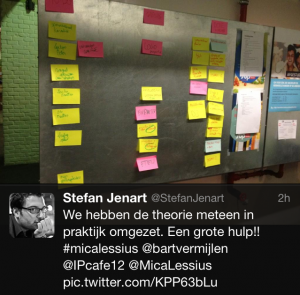
I had the honor to give a guest lecture on lean and agile at Lessius Hogeschool last week. A class of 17 students “Postgraduate Manager in Interactive Communication (MICA)” was eager to learn everything on lean and agile during three sessions. MICA prepares account managers, project managers and strategists to work in the leading Belgian digital advertising agencies.

Practice what you preach
As agile is all about embracing change over following a plan, I had to apply this to the course. I had an initial scheme that changed drastically along the way, based on retrospectives I did with the students at the end of every session. As this was the first time I was talking for 8 hours about all these topics, continuous learning was a prerequisite.
I used a scrum board to guide the students through the topics, thus adding transparency and inspection.
Day 1
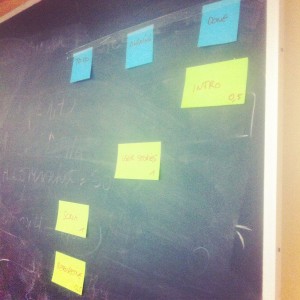
Practice first: user stories
To kick off with something practical, user stories seemed appropriate. After a quick introduction, the students had to make a backlog for a known application, in this case Twitter. I introduced the concept of a Minimum Viable Briefing.
Everything was timeboxed. At the end of every timebox I provided feedback and gave some tips to all three groups.
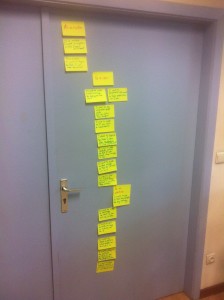
I was happy to see that after 4 timeboxes, everybody grasped the 3 C’s pretty well (conversation, card, confirmation). They wrote down the user stories on post-its and used the doors to present their backlogs (as the walls weren’t exactly post-it friendly). Of course I also shared with them how to peel off a sticky note.
Scrum basics
The next part of the session was about Scrum (as a second application of agile). I started with a presentation I did a few years ago on a barcamp. This was actually not easy, as Scrum is something really abstract for students who don’t have experience with managing software projects.
Retrospective
I ended the first day with a retrospective, using a variation on the Actions for Retrospectives-game. The students had to pair up and write down good things, bad things, flowers (compliments) and light bulbs (ideas). Afterwards it was my task to match some actions.
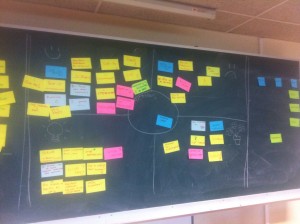
The results were instant and very clear. They liked the interaction in the user stories exercise, but they really needed some concrete examples on scrum. So I went home and made a small presentation with some Scrum cases. Instant feedback and instant adaptation.
Day 2
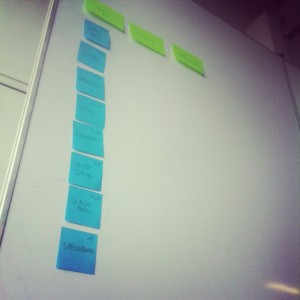
Scrum cases
As promised at the end of the first day, I started the second day with some scrum cases. I showed my refrigerator at home, which is a mini scrum board for householding, and the beautiful barbecue scrum board from Henrik Kniberg. Most important, I took a project from a few years ago, starting from the real briefing, showing pictures from the actual scrum board we used at the time.
Agile manifesto, lean and kanban
I illustrated the agile manifesto through Little Britain. I didn’t have a really good example on Kanban, but one of the students mentioned the Goldratt example as a nice addition. As cases showed to be important, I finished with a specific scrumban case.
Multitasking name game
To illustrate what happens when you switch from multitasking to one-piece-flow, I used the Multitasking Name Game.
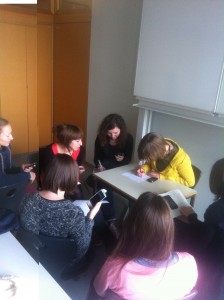
Speedboat
As speedboat happens to be one of the games I like most for retrospectives, I used it to get some more insights from the students. They had to draw a speedboat on the topic “Me working in an advertising agency”.
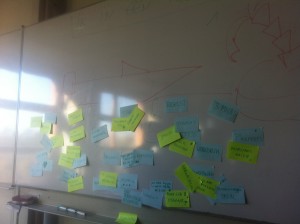
Retrospective
Again, we did the actions for retrospectives game. And again, the theory on kanban was perceived a little fuzzy. I decided to strip the third day from as much theory as possible.
Day 3
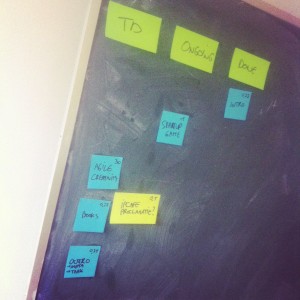
Lean startup game
The students were asked to develop an idea for an application. The customer was an online shoe shop. I guided the students from their general idea, through a specific customer segment, to a specific value proposition. Afterwards they had to decide which would be their Minimum Viable Product.
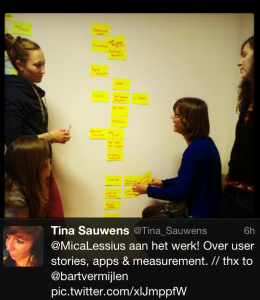
This time I talked about the theory afterwards, explaining the Lean Startup and Business Model Canvas.
Agile Creativity
Think with Google’s edition on Agile Creativity was the perfect roundup. It links agile, lean, user stories, lean startup, applied on digital agency culture.
Bonus
I was happy to have a lot of active participation from the students. After the last seminar they had to organize a homecoming event for alumni students. I was thrilled to see they had made a scrum board for the event, immediately applying what they learned. Awesome!
